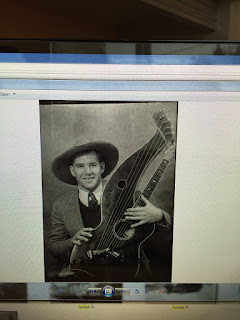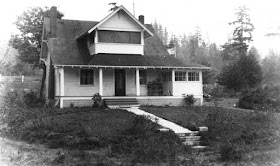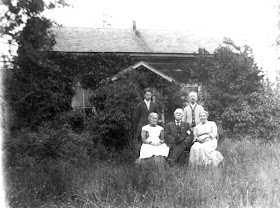Nice Day. Arose at 3 AM and pulled Anderson's scow out to Armstrongs Brick Yard and loaded 2275 tile with small load and boot them to 15th St. dock and discharged the same returning to "corral"
© 2012 Harbor History Museum. All rights reserved.
Pages
▼
Wednesday, March 28, 2018
Thursday, March 22, 2018
Clarence John Fuchek
Clarence John Fuchek
(9/30/1899-12/13/1988)
Once again we are attempting to reconstruct the little known story of a man during the early days of the 20th century. I have a feeling that one of our readers will be able to fill in some of the background on this man.
Clarence’s father, John Edward, was born in Czechoslovakia but his family immigrated and arrived in Wisconsin in 1875. Little is known although I did not review all the US Census reports until his family tree on ancestry.com tells us he is living in Pierce County, Washington as a single man. Since his occupation is listed as a stationary engineer, I am assuming (bad thing to do especially in history) that he is working with the railroad. John, age 32, meets Rose Kocourek, age 18, another Czechoslovakian and they married in 1898.
The following year they are living in Boisfort and PeEll Precincts, Washington, where Clarence is born. By 1903 the family has moved to Tacoma; and lived in the Oakland Addition on Center Street. This is where his sister Alice Florence Marie is born in 1903. The family grows with twin boys in 1905, a daughter in 1907 and again in 1909 and twin boys again 1909, a son in 1912, another son 1919 and a daughter in 1917. (ancestry.com)
Clarence recorded an oral history for the Gig Harbor Peninsula Historical Society on October 7th, 1987 and he died the following year at age 88. The oral history jumps around not only in topic but also years and is somewhat difficult to follow. But we’ll do our best to piece it together. Wish us luck!
When Clarence was 22 he married Marigold Lenaeux, also 22, and in 1927 they moved to Gig Harbor, Washington. In the very beginning in 1927 they lived several months near the Community Hall (Crescent Valley School/Community Hall/Masonic Temple/City of Gig Harbor Park). They then moved to a small cabin along the shore of Puget Sound called Nesika. (Nesika starts at the southside of the mouth of Gig Harbor’s harbor and goes along the shoreline behind Heron’s Key and Dolphins Reach; the cabins remaining use a street address of Craig Lane.) Unfortunately they couldn’t live there for long because vandals would throw rocks at it, breaking the windows and stealing their things, making it impossible for them to live there.
Then in 1929, Mitchell arranged it so Clarence was able to rent Joe Skansie’s house next to the Shell Station. He was living there on June 10, 1929 when the Gig Harbor hull burned and sunk.
Clarence goes to work for Mitchell Skansie in the Skansie Shipyard, and worked on both the Skansonia and its twin sister, Defiance. (The Skansonia is now a stationary wedding and event center on Lake Washington. (evergreenfleet.com) Mitchell then employs Clarence as purser on the ferries.
I was unable to find Marigold’s date of death, or if they divorced. But in 1933, Clarence marries Frank Samuelson’s daughter, Violet Ethel (1908-1980).
In 1938 construction started on the first Narrows Bridge and Clarence was supposed to get a job on the project. The State contractors called him, he worked four days or possibly five days and then they fired him. He was angry and you couldn’t blame him so he took a job at the Bremerton Naval Shipyard. One of Mitchell Skansie’s employees or perhaps Mitchell himself called Clarence and asked that he come back to help work on the ferries. They offered him $80 per month, more than he was making at the Naval Shipyard but Clarence refused. He finally had a steady job, working the swing shift and the war was on.
Then in 1945 with the war over, the Navy stopped the swing shift for the workers and put all the guys on day shift. This was the perfect opportunity for Clarence to get back into music.
Oh, yes, we haven’t mentioned that Clarence was a drummer and worked on and off with numerous bands in Pierce County have we? This is where finding information on the bands themselves becomes difficult. But Clarence and Vic Kiefer, another local musician, put together an orchestra and played during 1948-1949. Clarence’s last gig was New Years Eve 1949.
But when and where did he start? I don’t really know but most likely following his high school graduation. He played, over the years, in Longbranch, Harmony Hall in Home, Washington, Lake Bay, Horseshoe Lake, Gig Harbor and Tacoma. Clarence worked out of the Union Hall in Tacoma during his early band days for a while but didn’t like the way the Union Hall worked with the musicians. Some of the band names he played with were: Black Cats (4-piece dance band); Big Keeper (last place they played was Point Villa Hotel in Tacoma in 1949/50 on New Years Ice; and Silver Glide dances in Gig Harbor as well as Barn & Bell in Tacoma.
The principal players he played with were: Vic Kiefer, saxophone; Garnet West who later became Garnet West Sheler, piano; Earl Webber, also a drummer; and Benny Dudary and his wife, Ruth. Oh, let’s not forget his playing with Rueben Berkheimer.
 |
| Rehn Motors "Chevy Dealership Dance, Point Fosdick |
 |
| Unknown Instrument and Individual - Is this also Clarence? Clarence was a drummer, but could he have also played this combination guitar and cello? |
Clarence’s wife Violet Samuelson Fuchek died October 26, 1980 and her obituary indicates that she was a homemaker and member of the Peninsula Lutheran Church. Her family had purchased their property in Cromwell, Washington in 1892 and she had lived her entire life in the Gig Harbor area. Clarence died December 13, 1988 at the Cottesmore Nursing Home. He and Violet had lived in their property on Reid Road for over 47 years. He asked that remembrances, if any, be made to the John Paul Jones Scholarship Fund.
Notes:
- ancestry.com
- Tacoma Public Library, Northwest Room
- The Peninsula Gateway/Tacoma News Tribune
- Evergreenfleet.com
- Harbor History Museum Research Files
© 2012 Harbor History Museum. All rights reserved.
Wednesday, March 21, 2018
Emmett Hunt Diary - Wednesday December 11, 1889
Cool and cloudy with some rain Took wood to yard this morn then lay by it till nearly noon then took scow back to woodpile and came to town and went on the beach to repair leaky cinders and bent rudder.
© 2012 Harbor History Museum. All rights reserved.
© 2012 Harbor History Museum. All rights reserved.
Wednesday, March 14, 2018
Emmett Hunt Diary - Wednesday December 4, 1889
Gloomy morn but very fine later with bright moonlight and a N. wind at night. Lay around and wrote a letter while waiting for the scow and at 4:20 pm pulled out but the breeze becoming strong we anchored at east Tacoma.
© 2012 Harbor History Museum. All rights reserved.
© 2012 Harbor History Museum. All rights reserved.
Thursday, March 8, 2018
Old Town Historic Doctor’s home still stands on harbor’s east shore by Gladys Para
Old Town
Historic Doctor’s home still stands on harbor’s east shore
by Gladys Para
Wednesday, October 9, 1985
When a man builds a house to shelter his late years and that house continues to get refuge to his descendants down to his grandson’s children, his house speaks to them for him. His person can be felt even by those of his family who never met him.
Hiram Herbert Rust, M. D., built such a house in 1915 on the east shore of Gig Harbor’s head, and named it Rhododendron Terrace. The house stands on today’s Randall Drive between Vernhardson and 89th, one of the few early homes remaining along the waterfront.
It is owned by Mabel Wiggin Johnston, widow of Dr. Rust’s grandchild, Herbert B. Johnston. The couple’s daughter, Arveida Johnston Livingston, Gig Harbor, has continued the family Fourth of July picnics her mother began long ago, when visiting with Wiggin relatives was an important weekend activity. This year, 76 guests gathered at the old house where she grew up.
Like their father before them, Arveida and her three brothers grew up playing daily on the beach and attending Crescent Valley school. And at home they were surrounded by the doctor’s old books and belongings and by respect for the family possessions.
There was much to remind them. The families were savers and writers. The diaries of great-grandparents Dr. Rust and his wife Estella, and of grandmother Etta Sheldon Johnston, Estella’s daughter, are filled with Gig Harbor names and instructive glimpses of the community’s lifestyle, covering the period 1891 through 1927.
Their family diaries were as familiar to the Johnston children as were their other playthings in the sloping upstairs closets, the content’s of Great Grandmother’s trunks and of Great-Grandfather’s many glass-doored bookcases. Grandmother Etta gave away old furniture; their mother Mabel discarded all the dead medicine bottles she found when cleaning. But no one, of the four generations that have lived in the house, has cast out the doctor’s top hat, his seashells and original landscapes, nor changed the character of the home that still shows his version of The Good Life in Gig Harbor.
Rhododendron Terrace, named for the sweep of land around which Dr. Rust and patients drove their buggies to arrive at his office door, was his third house constructed on the beachfront acreage he purchased in 1891. A year after William R. Rust arrived from Ellenburg Depot, New York, he brought his wife and two stepchildren, Fred and Etta Sheldon, and moved into a roomy but plain dwelling of a style then common to local farms.
It stood on the site now owned by Tom Wagner until 1935, when neighbor John Wheeler tore it down for its lumber. The second house, called “Wild Rose Cabin,” was used as a summer home by the Rusts during the years they were away developing business property in Enumclaw. Daughter Etta and husband Arthur E. Johnston later rented it out for $3 cash to summer campers during the hard, slow years of the Depression.
It was his 1915-modern, three bedroom home, completed seven years before his death at age 85, that expressed Dr. Rust’s achievements and the tastes he had formed. It had a kitchen that stretched from the back entry to the front of the house, where, glassed on three sides, it gave a view of the bay. It had a second-story sleeping porch, closed only by canvas, and a Delco electric power plant.
The doctor was not wealthy, but comfortable, and was what was then called “a man of many parts.” He pursued many private interests, yet moved in Progressive Party political circles and among local decision-makers. When the new Community Hall was being built, and when school district matters needed attention, he was part of it.
The nine-foot-high living room, fashionably finished with dark woodwork and a local stone fireplace, was the evening setting for reading Shakespeare and listening to music from the piano and the “graphophone.” At all times of the day there was visiting, with friends and patients who came calling. The house, while not large, was made with rooms that could be closed off from the passages connecting them, allowing hallways and stair landings that today would be considered waste space by any builder. However, the pleasure of ascending a staircase having two landings, with window-light from two levels and space enough to sit on the steps with a book, if one wished, perhaps offset the waste.
The old house, while retaining its own integrity, has been the scene of social shifts as well as change in the lives of its owners. From a gracious doctor’s residence it became a farmhouse for the Arthur Johnston’ small dairy. It was the final haven of son Herbert Johnston, a qualified Chief Engineer on local boats before his early death in 1939; and during Mabel Johnston’s long life there since, it has been the focal point for family members who love to return there.
The diaries arising out of this home place will be given by the family in duplicate form to the Peninsula Historical Society, where they will be available to researchers in local history.
Note:
The Peninsula Gateway
© 2012 Harbor History Museum. All rights reserved.
Wednesday, March 7, 2018
Emmett Hunt Diary - Wednesday November 27, 1889
Calm and mild - no sun - no rain Steamed out to Clay Works with scow then up to Collyer Yard to find the scow still loading so came away and played the "seaside" a small joke on the way down - there toward piledriver from Old Town to draw and quiet satisfied.
© 2012 Harbor History Museum. All rights reserved.
© 2012 Harbor History Museum. All rights reserved.







